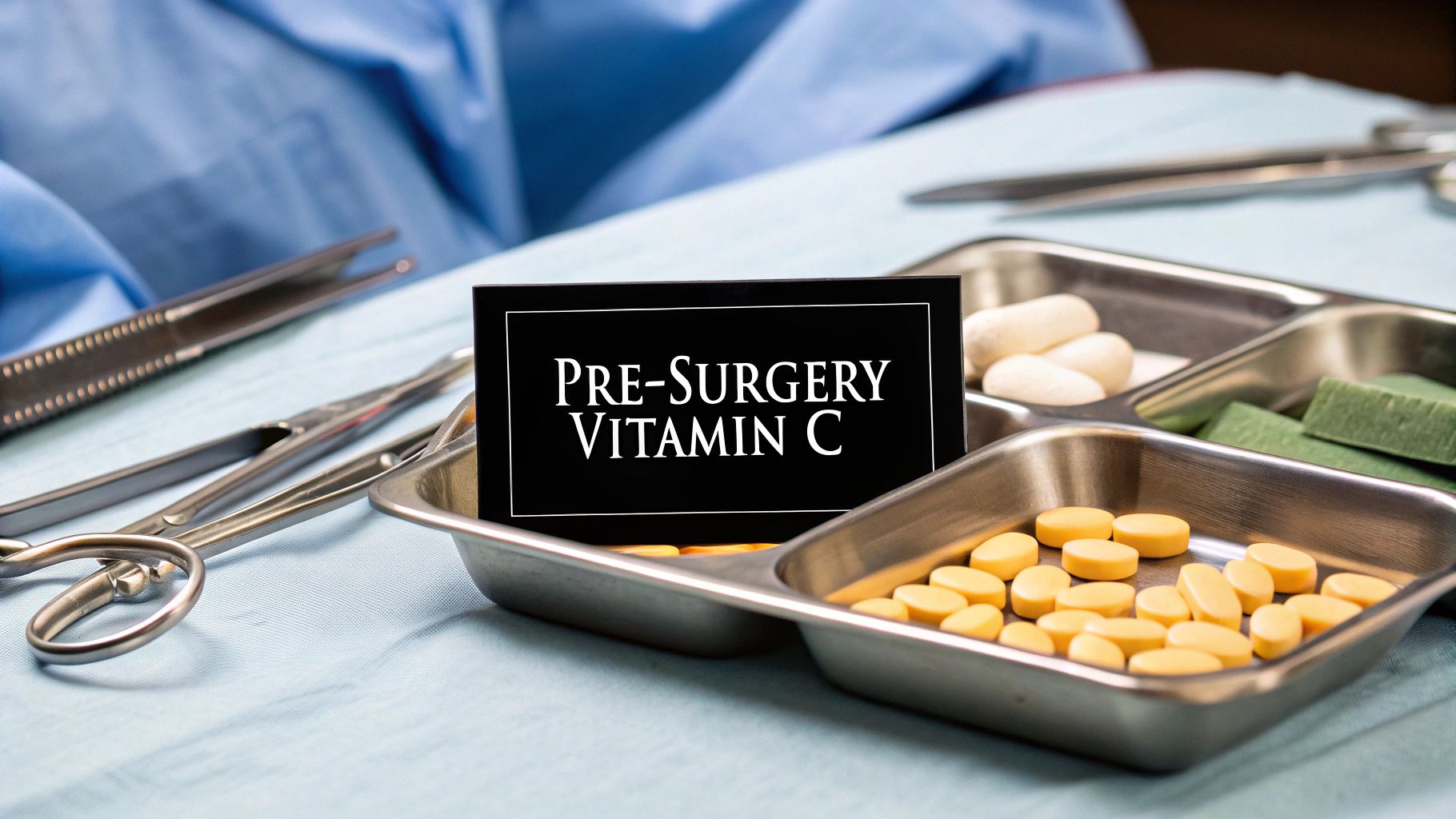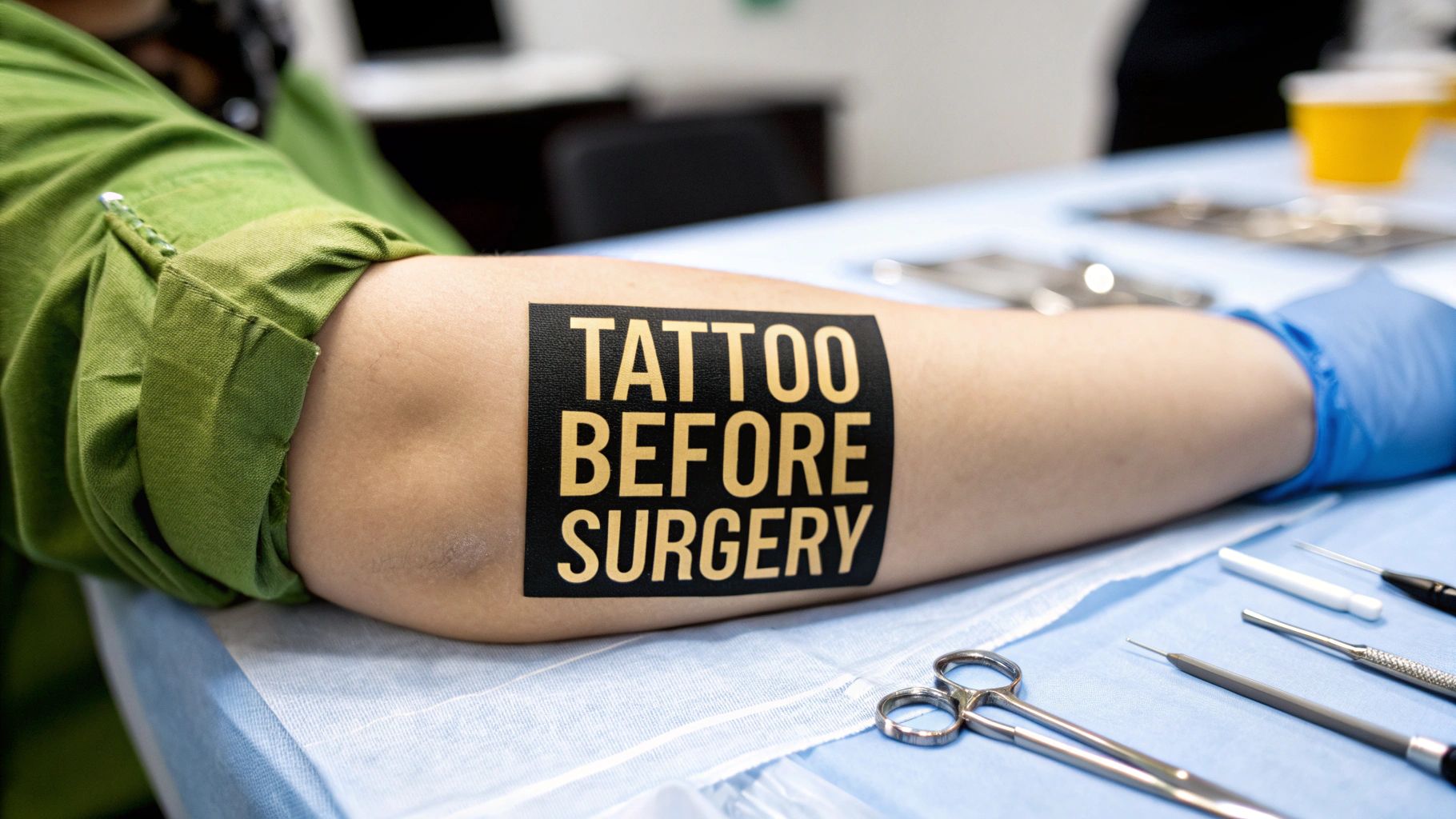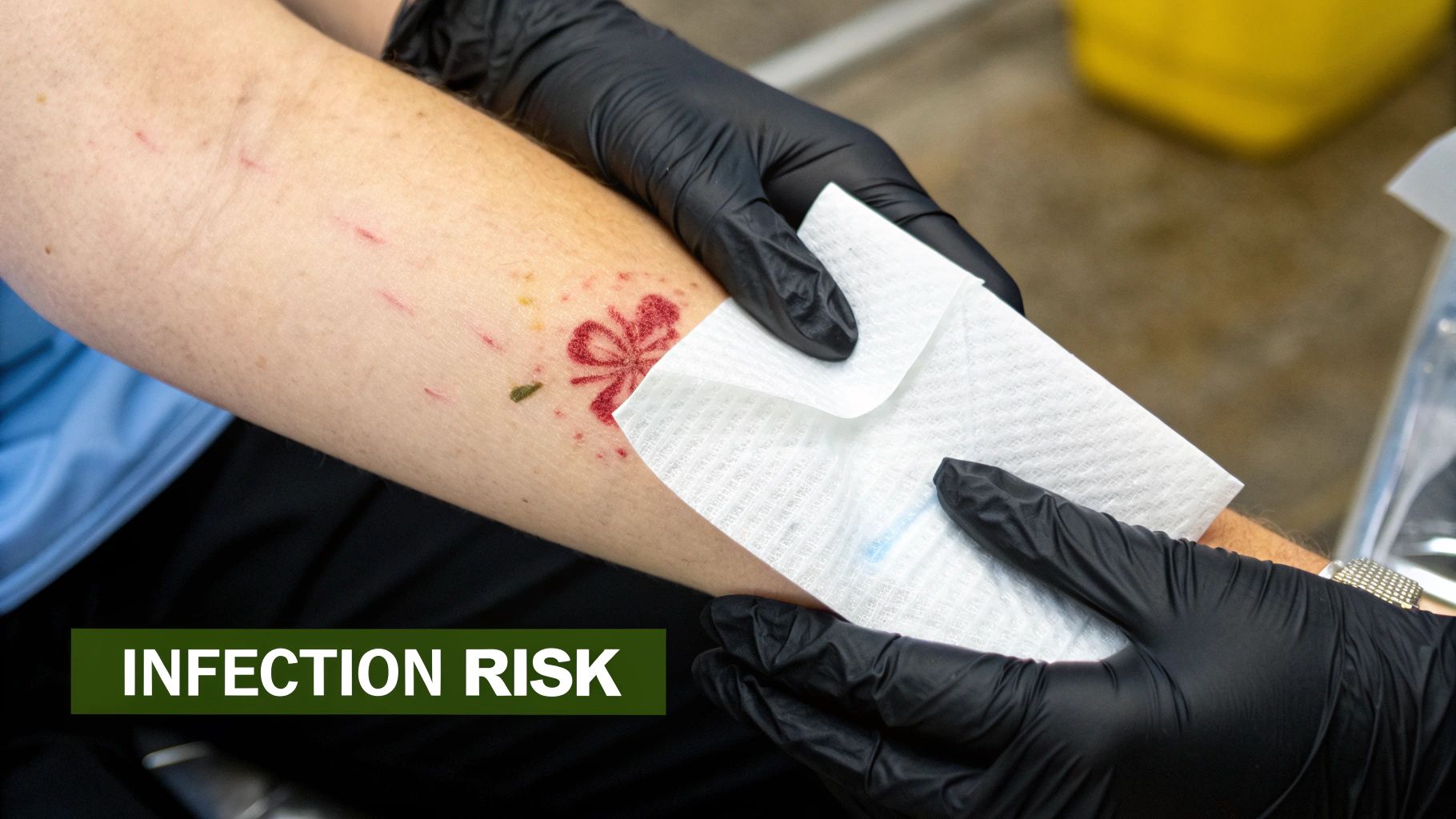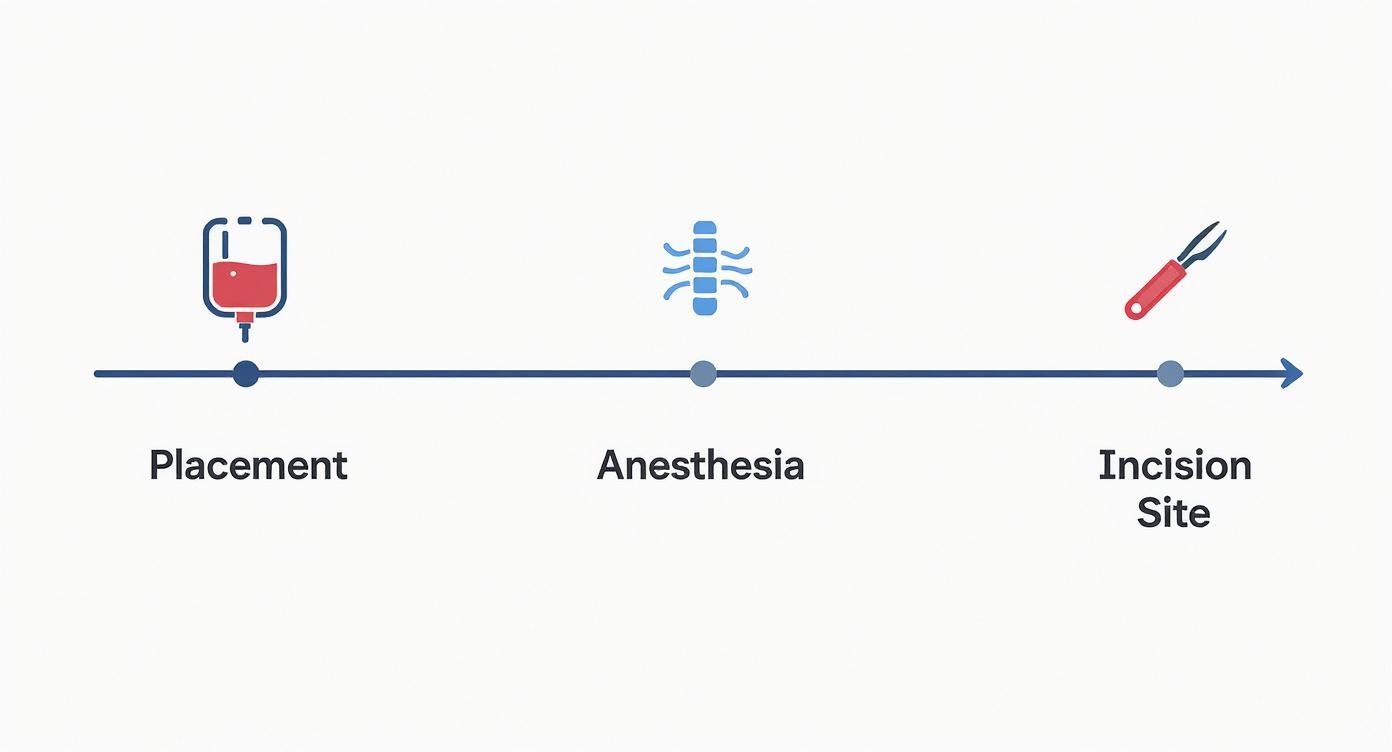
November 22, 2025
Taking Vitamin C Before Surgery An Expert Guide
Considering vitamin C before surgery? This guide covers the science-backed benefits for healing, potential risks, and crucial advice from surgeons.
Nov 20, 2025

So, you're thinking about getting some new ink and you also have surgery scheduled. A common question we hear is, "Can I get a tattoo before my procedure?"
The short answer? It's a really bad idea. As a surgeon, I strongly advise against getting any new tattoos close to a scheduled operation. It might seem like two unrelated things, but a fresh tattoo is essentially an open wound, and healing it pulls critical resources away from your body right when it needs to be gearing up for surgery.

Getting a tattoo right before surgery is like scheduling a big party the night before you run a marathon. You’re introducing unnecessary risks that can seriously compromise your health and the outcome of your operation.
Think of your immune system as a dedicated team of emergency responders. Your upcoming surgery is a major, scheduled event that requires their full, undivided attention.
Getting a new tattoo is like calling 911 for a non-emergency right before that big event kicks off. It forces your immune system to split its focus. Part of the team rushes off to deal with the thousands of tiny puncture wounds in your skin, while the other part is trying to prep for the surgical trauma ahead. This division weakens your body's defenses, leaving you far more vulnerable when you need to be at your strongest.
At its heart, the issue is a battle for resources. Your body has a limited supply of energy to manage inflammation, fight off bacteria, and repair tissue. A new tattoo triggers a major inflammatory response and kicks your healing processes into high gear.
Your body's top priority should be preparing for your operation. Forcing it to heal fresh ink and a surgical incision at the same time is like asking your immune system to work double shifts with no extra help.
This added "immune load" is a gamble you just don't want to take. Any complication with your tattoo—like an infection or even a bad allergic reaction to the ink—could force your surgeon to postpone or even cancel your procedure. That’s not just an inconvenience; for medically necessary surgeries, a delay can have serious health consequences. When you weigh the options, the temporary thrill of new body art just doesn't compare to the critical importance of a safe and successful surgery.
The decision becomes pretty clear when you lay out the pros and cons. The potential health risks are significant, while the rewards are minimal and fleeting.
Ultimately, the goal is to have the safest and smoothest surgical experience possible. Adding a fresh tattoo to the mix is an unnecessary complication that works directly against that goal. It's always best to wait.

It might seem like no big deal to get some fresh ink before a scheduled surgery, but from a medical standpoint, it introduces some serious risks that could jeopardize the whole procedure. Taking a moment to understand why it's a problem is key to making a smart choice for your health.
The biggest and most immediate danger is infection. Let's be clear: a new tattoo is an open wound. The artist uses needles to puncture your skin thousands of times, breaking its natural protective barrier. This creates an open door for bacteria to walk right in.
This isn't just a hypothetical risk. If bacteria like Staphylococcus get into that fresh tattoo, you could be looking at cellulitis—a nasty skin infection that causes redness, swelling, and pain. Worse, that localized infection could go systemic, spreading through your bloodstream. An active infection anywhere in your body is a red flag that will almost certainly get your surgery postponed.
Beyond the risk of picking up a bug, a new tattoo puts a real strain on your body’s defenses. Think of your immune system as your personal security team. Before a planned surgery, that team is already on high alert, getting everything ready for the physical stress and healing that’s about to happen.
Getting a tattoo forces that team to split its focus. All of a sudden, your body is trying to heal a large skin wound and prepare for a major operation at the same time. It’s a classic case of being pulled in two different directions.
A compromised immune system is less effective at fighting off potential post-surgical infections and can lead to a slower, more complicated recovery. You're essentially asking your body to run a marathon and a sprint at the exact same time.
This "immune load" is a crucial concept. By adding the stress of healing a tattoo, you're weakening your body's ability to handle the main event—your surgery. You want your immune system rested, focused, and fully prepared for a smooth recovery.
Another wrench in the works is the possibility of an allergic reaction to the tattoo ink. It’s not incredibly common, but some people react badly to the pigments, especially reds, yellows, and blues. This can kick off an inflammatory response that creates a real headache for your medical team.
Why? Because the symptoms of an allergic reaction can look a lot like a post-op infection:
When your surgical team is watching you closely for any sign of trouble, this kind of clinical "noise" is the last thing you want. They need clear signals about how your body is healing from the operation itself. An ink reaction adds a confusing variable that can lead to unnecessary stress, extra tests, and even the wrong treatment.
Proper aftercare is crucial for any new ink, and that includes knowing a practical guide on how to sleep with a new tattoo to keep it clean and irritation-free. But this is just as important as knowing how to care for surgical incisions. By avoiding new tattoos right before your procedure, you ensure your body can send clear signals to your doctors, setting you up for the safest possible recovery.
Beyond general health risks like infection, a tattoo can create very real, hands-on problems for your surgical team in the operating room. It's not just a matter of healing; a new or even heavily saturated tattoo can become a physical obstacle that gets in the way of the precise work surgery requires.
Think of your skin as a clear roadmap for your surgeon and anesthesiologist. A fresh tattoo is like a massive detour or a section of the map that's been scribbled over, hiding critical landmarks they need to see. This is particularly important for monitoring your skin's health during and after the procedure.
Surgeons are trained to spot the earliest, most subtle signs of trouble, like a faint blush of redness or slight swelling around an incision. A dark, vibrant tattoo can completely hide these visual cues. This could delay the diagnosis of a complication at the very moment when catching it early matters most.
One of the biggest hurdles a tattoo can create is for your anesthesiologist. Many surgeries depend on safely placing intravenous (IV) lines for medication or administering regional anesthesia like an epidural, and a tattoo in just the wrong spot can turn a simple step into a serious challenge.
For example, if you have a new tattoo sleeve, the anesthesiologist might struggle to find a clear, healthy vein for an IV. They need to be able to see the vein, and an arm that’s swollen and tender from fresh ink makes that task much harder—and potentially more painful for you.
The same goes for spinal and epidural anesthesia, which are essential for many lower-body surgeries. If you have a large tattoo covering your lower back, your anesthesiologist is put in a tough spot.
There's a theoretical risk that inserting an epidural needle through a tattoo could carry pigment particles into deeper tissues, potentially near the spinal canal. While many experts consider this risk to be very low, your medical team will always err on the side of caution. They'll typically search for a small patch of clear skin to avoid any potential issues.
This could mean it takes a few more tries to place the needle correctly, or it might even prompt a change in the entire anesthesia plan. It’s a perfect example of how your body art can directly shape your medical treatment.
For your surgeon, the main issue is the integrity of the surgical site itself. They plan incisions with incredible precision to hide them in natural creases, ensuring the best possible healing and the least noticeable scar. A tattoo right over the planned surgical area can throw a wrench in those plans.
These are exactly the kinds of challenges that make open communication with your care team at Cape Cod Plastic Surgery so important. When you're upfront with Dr. Marc Fater about any recent or planned tattoos, we can get ahead of these issues and tailor the surgical plan for your specific situation. Your safety and an incredible result are always our top priorities.
The administration of anesthesia is governed by incredibly strict safety standards. The American Society of Anesthesiologists has established clear guidelines to protect patients, ensuring care is only provided by qualified professionals. When a tattoo is present, the anesthesiologist has to carefully evaluate any potential interference, which is just one part of their professional oversight. It’s no surprise that medical research shows 92.2% of patients receiving physician-led anesthesia care report high satisfaction. To learn more, you can read the full research on anesthesia safety standards and see why these rigorous protocols are in place.
Figuring out when to get a tattoo around a scheduled surgery can be confusing. You’ll hear all sorts of conflicting advice, but in the medical world, the consensus is pretty clear: give your body time. A little patience goes a long way in protecting your health and making sure your new ink looks great for years to come.
The goal is simple—let your body wrap up the most demanding part of healing from one event before you throw another one at it. Think of it this way: you wouldn't start a new construction project on a foundation that's still curing. It just creates problems.
Getting a tattoo is, essentially, creating a large, open wound. Your skin's protective barrier is broken, and for the first few weeks, your immune system is working on overdrive to fight off germs, close the wound, and start rebuilding tissue. That’s when you’re most at risk for an infection.
As a firm rule, you should wait a minimum of 4 to 6 weeks after getting a tattoo before undergoing any surgical procedure. This timeframe is crucial for allowing the epidermis—the top layer of your skin—to heal over, which dramatically cuts down your infection risk.
Giving it at least a month lets your immune system catch its breath so it can be ready for the stress of your operation. Trying to squeeze it in any sooner is a gamble that could force your surgeon to postpone the procedure.
This timeline also shows how a recent tattoo can get in the way of essential surgical steps, like placing an IV, administering anesthesia, or even making a clean incision.
As you can see, a fresh tattoo isn't just a skin issue; it can create multiple headaches during the entire surgical process.
So, what about getting a tattoo after your operation? Here, the timeline gets even longer, and for good reason. Your body has just been through a major event, and all its resources are focused on healing the surgical incision and the tissues underneath. This is a far deeper and more complex healing process than a tattoo.
Waiting isn't just about preventing infection. It’s also about ensuring a good outcome for both your scar and your tattoo. If you tattoo over scar tissue before it's fully mature, the ink won’t hold well, lines can blur, and the whole design can look uneven.
In general, you'll want to wait until your surgical scar is completely healed—meaning it's faded from that initial pink or red to a pale, silvery-white and isn't tender to the touch anymore. This process can easily take anywhere from 6 months to over a year.
To make scheduling easier, here’s a quick-reference guide. Remember, these are general timelines. The final green light should always come from your surgeon, like Dr. Marc Fater here at Cape Cod Plastic Surgery, who knows the specifics of your procedure and recovery.
This table provides a guide to safe scheduling for getting a tattoo before or after surgery, categorized by the type of medical procedure.
When you look at the big picture, waiting a few extra weeks or months is a small price to pay for your safety and a beautifully healed tattoo. Prioritizing your health first guarantees you’ll be able to enjoy your new body art without complications or regrets down the road.
While the general advice to wait is a great rule of thumb, the stakes get much higher with certain surgeries—especially cosmetic and reconstructive procedures. Here, the timing and placement of new ink isn't just a safety issue; it's about protecting the very outcome you've invested in.
Think about it: a minor arthroscopic knee surgery is worlds away from a procedure that involves large incisions and significant tissue remodeling, like a tummy tuck or breast augmentation. For these cosmetic surgeries, the final look is the primary goal, and a poorly timed tattoo can absolutely get in the way of a beautiful result.
When a procedure is designed to reshape or contour your body, your skin and the tissue beneath it are placed under very specific tension. If you get a tattoo anywhere near a future incision site, that tattoo can end up distorted, stretched, or warped by the surgery.
It’s like commissioning a beautiful painting on a canvas, only to have someone pull and reshape that canvas afterward. The art is going to change. That’s exactly what can happen to a tattoo near the surgical site for procedures like:
Tattoos are more popular than ever, and medical professionals are well aware of this. In fact, about 30% of all Americans have at least one tattoo. This growing trend makes clear communication between patients and their doctors absolutely essential. You can discover more insights on tattoo safety from the FDA to see why this conversation matters so much.
While your surgeon will ask about your medical history, it's your responsibility to be your own best advocate. Always volunteer information about recent tattoos or any you plan to get near the surgery date.
Bringing up your body art isn't just a formality. It gives your surgical team, like Dr. Marc Fater here at Cape Cod Plastic Surgery, the full picture they need to make the best decisions for your health and your aesthetic goals. It ensures there are no surprises on the day of your operation.
Your surgeon can give you personalized advice based on the exact incision plan and the type of surgery you're having. This simple conversation helps protect you from complications and makes sure that both your surgical results and your tattoos look their best for years to come. Being proactive and transparent is truly the most important step you can take.

When you're trying to figure out if you can get a tattoo before surgery, the answer really boils down to being proactive and putting your safety first. Rather than crossing your fingers and hoping for the best, this checklist will help you make smart choices that protect your health and set you up for a smooth surgical outcome.
Think of this as your game plan for managing your body art and your medical needs like a pro. And the number one rule? Full transparency with your medical team.
During your surgical consultation, you have to tell your surgeon and anesthesiologist about any recent tattoos—or any you’re planning to get. It’s not something you want to hide, as keeping it to yourself could put you at unnecessary risk. They need a complete picture of anything that might challenge your immune system or interfere with the procedure.
This kind of open dialogue allows your surgeon, like Dr. Marc Fater here at Cape Cod Plastic Surgery, to give you advice that’s specific to your health and the operation you’re having. For a broader look at getting ready, our guide on https://www.ccplasticsurgery.com/blog/how-to-prepare-for-surgery is a great resource that complements this checklist.
If you do decide to move forward with a tattoo well ahead of your surgery date, picking the right artist and shop is one of the most important safety steps you can take. A highly professional, sterile environment is your first line of defense against infection.
Don't compromise on these standards:
Even when you go to a fantastic artist, there’s always a small risk of infection. Knowing what to look for is absolutely crucial for catching a problem early and preventing complications that could put your surgery on hold.
A healing tattoo is normally a bit red, swollen, and tender. An infection is a whole different ballgame. Be on the lookout for spreading redness that darkens or forms streaks, any yellow or green pus, pain that gets worse after the first couple of days, or a bad smell. A fever is a major red flag—call your doctor right away.
Following these steps puts you in the driver's seat, ensuring both your new art and your health are well cared for. As you get all your ducks in a row, it's also a great idea to get your hospital essentials organized. Using a practical hospital bag checklist can take some of the stress out of packing and make sure you’re comfortable during your stay.
It's completely normal to have questions swirling around when you're planning for a surgery but also thinking about your next piece of body art. Let's clear up some of the most common concerns we hear from patients.
This is a huge worry for a lot of people, and understandably so. The short answer is: we try our absolute best not to. Surgeons know your tattoos are a meaningful part of who you are, and we'll always look for an alternative incision site, like along the tattoo's border or tucked into a natural skin crease.
That said, our number one priority is always your health and a successful surgical outcome. If the only safe and effective place to make an incision is right through your ink, then that's what we have to do. The integrity of the procedure will always come first.
When it comes to tattooing over or near a surgical scar, patience truly is a virtue. Your incision might look sealed and healed on the surface in just a few weeks, but the deeper layers of tissue are still working hard to remodel and regain their strength. This process takes time.
We strongly recommend waiting a minimum of 6 to 12 months after surgery before tattooing the area. This waiting period gives the scar tissue enough time to mature—meaning it softens, flattens out, and becomes stable.
Tattooing on a fresh, immature scar is a recipe for a bad result. The ink can blur or "blow out," the lines can become distorted as the scar continues to change, and you even risk re-injuring the skin. Always check with your surgeon before you book that tattoo appointment; they can tell you if your scar is ready.
This is a persistent myth, especially when it comes to getting an epidural. The theory is that the needle could potentially drag tattoo pigment into the spinal canal, causing a problem. While anesthesiologists are aware of this theoretical risk, the actual chance of it causing any complication is incredibly small.
In the real world, your anesthesiologist is an expert at finding a small patch of clear skin on the lower back to safely place the epidural. They can almost always work around the ink. For general anesthesia, tattoos present no issue whatsoever. So, while you should always be honest about your tattoos during your pre-op consult, you can rest easy knowing it’s almost never a roadblock to getting the pain management you need.
Figuring out how your surgical plan fits with your aesthetic goals is what we do best. Here at Cape Cod Plastic Surgery, Dr. Marc Fater works with each patient to develop a safe, effective approach that respects both your body and your art.
Ready to talk? Schedule your personal consultation with us today.

November 22, 2025
Considering vitamin C before surgery? This guide covers the science-backed benefits for healing, potential risks, and crucial advice from surgeons.

November 21, 2025
Does Latisse work for eyebrows? Get the science-backed answer. We explore results, proper use, side effects, and what to expect from this popular treatment.

November 21, 2025
A Comprehensive Overview of Body Contouring: Techniques, Benefits, and Recovery